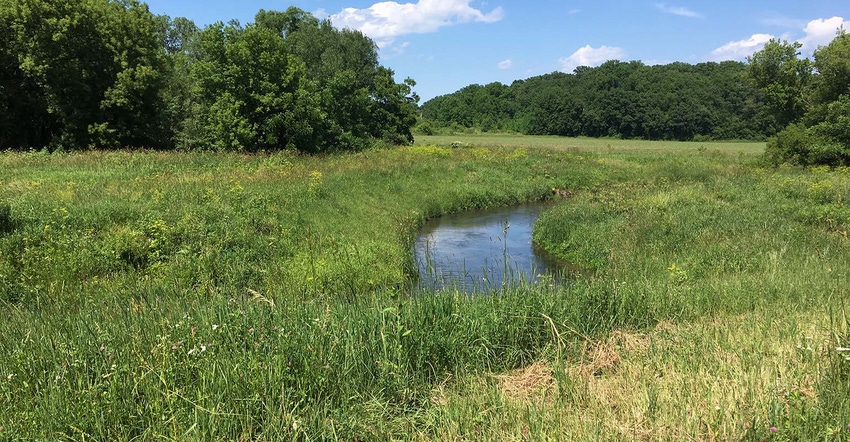October 13, 2021

The U.S. Department of Agriculture is investing $10 million in a new initiative to sample, measure and monitor soil carbon on Conservation Reserve Program acres to better quantify the climate outcomes of the program. This initiative will begin implementation in fall of 2021.
This announcement comes as part of a broader, long-term soil carbon monitoring effort across agricultural lands that supports USDA’s commitment to deliver climate solutions to agricultural producers and rural America through voluntary, incentive-based solutions.
“These CRP Climate Change Mitigation Assessment Initiative projects will survey, sample and measure the climate benefits of land enrolled in CRP conservation practice types over time,” says Zach Ducheneaux, Administrator of USDA’s Farm Service Agency. “This data will help USDA better target CRP practices to achieve continued climate wins across environmentally sensitive lands while strengthening our modeling and conservation planning resources for all producers.”
These models include the Daily Century Model, or DayCent, which simulates the movement of carbon and nitrogen through agricultural systems and informs the National Greenhouse Gas Inventory. Data will also be used to strengthen the COMET-Farm and COMET-Planner tools, which enable producers to evaluate potential carbon sequestration and greenhouse gas emission reductions based on specific management scenarios.
USDA partners will conduct soil carbon sampling on three categories of CRP practice types: perennial grass, trees, and wetlands.
Perennial grasses
In consultation with USDA, Michigan State University will sample and measure soil carbon and bulk density of CRP grasslands (including native grass plantings, rangelands and pollinator habitat plantings) at an estimated 600 sites across the U.S. with a focus in the central states during this five-year project. This information will be used to model and compare the climate benefits of CRP. Partners include the University of Wisconsin-Madison, the University of Arkansas at Pine Bluff, Deveron and Woods End Laboratories.
“Our interdisciplinary team is excited to work with FSA on assessing, monitoring and modeling the climate benefits of CRP,” says Professor Bruno Basso, Michigan State University. “Our proposed integrated system for sampling and modeling soil organic carbon accrual and ecosystem services in CRP lands aims to maximize climate outcomes to mitigate the deleterious effects of climate change on our planet”.
Trees
Mississippi State University will partner with Alabama A&M University to collect above and below ground data at 162 sites across seven states documenting CRP-related benefits to soil and atmospheric carbon levels. Information will help further calibrate the DayCent model. This five-year project will focus within the Mississippi Delta and Southeast states.
“There are hundreds of thousands of acres of trees planted under the CRP program in Mississippi and neighboring states that make a substantial contribution to climate change mitigation, but we don’t have a good idea how large that contribution is,” says Austin Himes, assistant professor at Mississippi State University. “This incredible team of partners will use a mix of traditional forestry measurements and state of the art technologies to get an accurate estimate of those benefits, which in turn can help policy makers incentivize tree planting. Additionally, we get to train students to collect all that data, providing them hands-on experience.”
Wetlands
Ducks Unlimited and its partners will collect data on carbon stocks in wetland soils as well as vegetation carbon levels at 250 wetland sites across a 15-state area in the central U.S. Data will support the DayCent and additional modeling. Partners for this five-year project include Migratory Bird Joint Venture, Intertribal Research and Resource Center at United Tribes Technical College, Clemson University, Kenyon College, Lincoln University, Pennsylvania State University, the University of Missouri and the University of Texas at Austin.
“We’ve long known wetlands offer many ecosystem services that have an outsized benefit for wildlife and people” says Dr. Ellen Herbert, DU’s Ecosystem Services Scientist. “This study will help improve our understanding of the potential of CRP restored wetlands to mitigate the effects of climate change, improve water quality and provide habitat. We hope the data gathered from this study will ultimately help demonstrate the effectiveness and overall values of CRP. And, we greatly appreciate USDA for selecting DU to partner in this project.”
CRP monitoring, assessment and evaluation projects
These three Climate Change Mitigation Assessment Initiative projects are funded through FSA’s program to work with partners to identify Monitoring, Assessment and Evaluation projects to quantify CRP environmental benefits to water quality and quantity, wildlife and rural economies.
Applications for projects were welcome from all organizations, including public, private, nonprofit institutions and educational institutions including historically Black colleges and universities, Tribal colleges and universities and Hispanic-serving institutions or organizations.
For more details on the all the awarded MAE projects, visit FSA’s Monitoring Assessment & Evaluation webpage.
Source: USDA, which is solely responsible for the information provided and is wholly owned by the source. Informa Business Media and all its subsidiaries are not responsible for any of the content contained in this information asset.
Read more about:
ClimateAbout the Author(s)
You May Also Like




